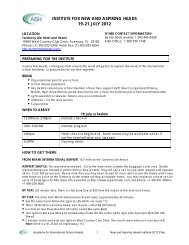AISHnet Survey - Academy for International School Heads
AISHnet Survey - Academy for International School Heads
AISHnet Survey - Academy for International School Heads
You also want an ePaper? Increase the reach of your titles
YUMPU automatically turns print PDFs into web optimized ePapers that Google loves.
lost in this process, whereas, in fact, the “lost” water plays an important role<br />
in transporting nutrients around the plant.<br />
A middle school mathematics teacher might ask students to indicate how<br />
many fractions they can find between 1/6 and 1/7. Some students will think<br />
there aren't any; others may suggest an answer that, although in some way<br />
understandable, is an incorrect use of mathematical notation, such as 1 over<br />
6½. The important feature of such range-finding items is that they can help a<br />
teacher judge where to begin instruction.<br />
Of course, teachers can use the same item in a number of ways, depending<br />
on the context. They could use the question about fractions at the end of a<br />
sequence of instruction on equivalent fractions to see whether students have<br />
grasped the main idea. A middle school science teacher might ask students at<br />
the end of a laboratory experiment, “What was the dependent variable in<br />
today's lab?” A social studies teacher, at the end of a project on World War II,<br />
might ask students to state their views about which year the war began and<br />
give reasons supporting their choice.<br />
Teachers can also use questions to check on student understanding<br />
be<strong>for</strong>e continuing the lesson. We call this a “hinge point” in the<br />
lesson because the lesson can go in different directions, depending<br />
on student responses. By explicitly integrating these hinge points into<br />
instruction, teachers can make their teaching more responsive to their<br />
students' needs in real time.<br />
However, no matter how good the hinge-point question, the traditional model<br />
of classroom questioning presents two additional problems. The first is lack of<br />
engagement. If the classroom rule dictates that students raise their hands to<br />
answer questions, then students can disengage from the classroom by<br />
keeping their hands down. For this reason, many of our teachers have<br />
instituted the idea of “no hands up, except to ask a question.” The teacher<br />
can either decide whom to call on to answer a question or use some<br />
randomizing device, such as a beaker of Popsicle sticks with the students'<br />
names written on them. This way, all students know that they need to stay<br />
engaged because the teacher could call on any one of them. One teacher we<br />
worked with reported that her students love the fairness of this approach and<br />
that her shyer students are showing greater confidence as a result of being<br />
invited to participate in this way. Other teachers have said that some students<br />
think it's unfair that they don't get a chance to show off when they know the<br />
answer.<br />
The second problem with traditional questioning is that the teacher gets to<br />
hear only one student's thinking. To gauge the understanding of the whole<br />
class, the teacher needs to get responses from all the students in real time.<br />
One way to do this is to have all students write their answers on individual<br />
dry-erase boards, which they hold up at the teacher's request. The teacher



